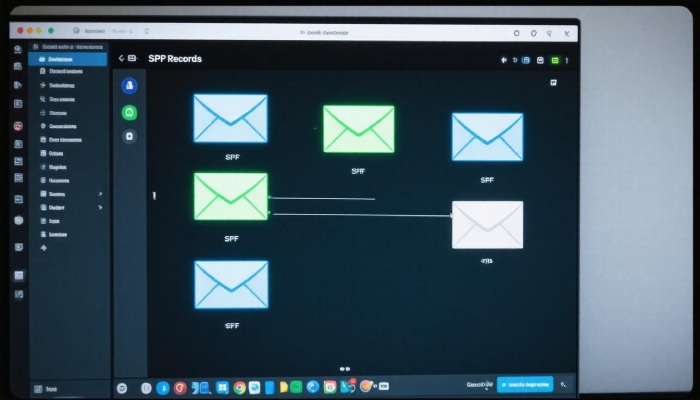Understanding SPF and Its Role in Email Authentication
In the landscape of modern email security, the Sender Policy Framework (SPF) plays a pivotal role in email sender authentication and combating email spoofing. SPF is a protocol that enables domain owners to specify which mail servers are authorized to send emails on their behalf through an SPF record published in the DNS TXT record of the domain. This record serves as a critical piece in the triad of authentication standards alongside DKIM (DomainKeys Identified Mail) and DMARC (Domain-based Message Authentication, Reporting & Conformance).
When an email is received, the recipient’s mail server performs a DNS lookup on the sending domain’s SPF record. This lookup checks the IP address of the sending mail server against the IP address listing in the SPF mechanisms defined in the DNS TXT record. The result of this SPF validation — whether SPF pass, SPF fail, SPF neutral, SPF softfail, or SPF hardfail — influences the anti-spam measures that the receiving server applies, impacting overall email deliverability and email security.
SPF enables SPF alignment, ensuring that the envelope from address domain matches the domain authorized to send emails, reducing the risk of spoofed messages reaching the inbox or causing security alerts. Organizations using platforms such as Google Workspace, Microsoft Office 365, Amazon SES, Mailchimp, or SendGrid rely heavily on correctly configured SPF to maintain high inbox placement and avoid classification as spam or phishing attempts.
The Importance of Correct SPF Record Formatting
The proper configuration of an SPF record cannot be overstated. Since SPF records reside as DNS TXT records, they must adhere to strict SPF syntax and adhere to DNS size limits. Correct SPF formatting involves defining the SPF mechanisms and SPF modifiers to ensure authorized IP addresses and mail servers are precisely indicated without introducing syntax errors.
MSPs (Mail Service Providers) and security vendors like Proofpoint, Barracuda Networks, Mimecast, Cisco, and Trend Micro emphasize that even minor SPF record syntax errors can have sweeping effects on email deliverability. For instance, missing colons, improper use of mechanisms such as ‘include’, ‘a’, ‘mx’, ‘ip4’, or ‘ip6’, or exceeding the maximum DNS lookup limit of 10 can result in an SPF fail or SPF hardfail. This not only affects legitimate emails being rejected or deferred but also diminishes the effectiveness of email security frameworks like DMARC, which depend on SPF and DKIM results.
SPF flattening is often employed to simplify SPF records that include multiple nested mechanisms prone to multiple DNS lookups, a practice essential to circumvent DNS lookup limits while preserving SPF validation accuracy. Tools like Cloudflare, Google Postmaster Tools, G Suite Toolbox, and SolarWinds provide utilities to manage record optimization and flattening, supporting administrators in maintaining robust email sender authentication.
Common SPF Syntax Errors and Their Impact on Email Deliverability
SPF record syntax errors are surprisingly common but can have an outsized impact on email deliverability and security. The most frequent SPF record syntax errors include:
- Exceeding DNS Lookup Limits: SPF validation caps DNS lookups at 10 to prevent overloading DNS infrastructure. Records that invoke multiple ‘include’, ‘a’, or ‘mx’ mechanisms without flattening risk SPF fail due to too many DNS lookups.
- Improper Mechanism Usage: Incorrect use or omission of SPF mechanisms and modifiers can cause unexpected results, such as using ‘ip4’ addresses without proper formatting or forgetting mandatory qualifiers (‘+’, ‘-’, ‘~’, ‘?’).
- Missing or Malformed DNS TXT Records: If the SPF record is not published as a proper DNS TXT record, SPF validation may return neutral or fail results.
- Redundant or Conflicting Modifiers: Using multiple SPF modifiers like ‘redirect’ with ‘exp’ incorrectly can render the record invalid.

The consequences of these errors can be severe, especially for organizations leveraging platforms such as Microsoft Exchange, Zoho Mail, or integrating with third-party providers like Postmark, SparkPost, or SendGrid. Improper SPF records may cause emails to be marked as spam or rejected outright by spam filters managed by vendors like Proofpoint Essentials, Cisco Email Security, or FireEye, jeopardizing email communication and brand reputation.
Automated scanning by threat intelligence groups such as Talos Intelligence Group and anti-phishing systems by Symantec actively check SPF configurations to identify vulnerable domains susceptible to email spoofing. Hence, maintaining SPF syntax integrity directly contributes to reducing phishing threats and enhancing the overall email security posture.
What Is an SPF Format Checker and How Does It Work?
An SPF format checker is a specialized tool designed to analyze the SPF record’s DNS TXT record for syntax correctness, DNS lookup compliance, and adherence to best practices for SPF validation. These checkers parse the SPF syntax, evaluate the mechanisms and modifiers, and simulate DNS lookups to ensure the record will function optimally in real-world email authentication scenarios.
Popular SPF record testers include online utilities such as the Kitterman SPF Validator, MxToolbox SPF record checker, G Suite Toolbox, and advanced platforms integrated into solutions from DMARC Analyzer, Valimail, Agari, Dmarcian, and EasyDMARC. They provide comprehensive insights including:
- SPF Syntax Analysis: Detecting SPF record syntax errors like missing delimiters or invalid mechanisms.
- DNS Lookup Simulation: Verifying the total DNS lookup count to prevent SPF fail due to DNS lookup exhaustion.
- SPF Mechanism Evaluation: Validating the inclusion of mechanisms such as ‘include’, ‘ip4’, ‘ip6’, ‘a’, and ‘mx’, ensuring proper IP address listing.
- SPF Alignment Checks: Ensuring SPF alignment with domain policies for DMARC compliance.
- SPF Result Prediction: Predicting likely SPF outcomes (pass, softfail, neutral, fail) based on provided IP address input.
For administrators managing domains on services like Google Workspace, Microsoft Office 365, or Amazon SES, employing an SPF record generator combined with an SPF record checker is best practice. This method allows the crafting of a syntactically correct SPF record and immediate verification before publishing it to DNS to avoid propagation delays that could affect email deliverability.
In environments with complex mailing infrastructures, SPF flattening tools offered by providers such as Cloudflare or SolarWinds can be integrated with SPF format checkers to optimize the records proactively, enhancing the efficiency of DNS lookups while maintaining security coverage.

Integrating SPF format checker usage into routine domain management workflows complements other authentication methods like DKIM and DMARC. It serves as a foundational step in establishing a robust email authentication framework to deter spoofing and ensure that legitimate emails from platforms like Mailchimp, SendGrid, or Microsoft Exchange reliably pass security checks, boosting overall email security and trustworthiness.
Step-by-step guide to ensure your SPF record syntax is correct:
- Locate Your SPF Record: Before you begin, retrieve the current SPF record associated with your domain. This can usually be found in your DNS management console provided by your DNS hosting provider like Cloudflare or your email platform such as Google Workspace, Microsoft Office 365, Amazon SES, or SendGrid.
- Copy the SPF Record String: The SPF record typically starts with `v=spf1` and includes various SPF mechanisms (`ip4`, `ip6`, `include`, `all`) as well as modifiers. Copy this entire string.
- Access an SPF Record Checker Tool: Go to a trusted SPF record tester like Kitterman SPF Validator, MxToolbox, or SPF record tester features in platforms like Dmarcian or Valimail.
- Input the SPF Record String: Paste the SPF syntax into the text box or enter your domain to allow the tool to perform a DNS lookup and retrieve the existing SPF record.
- Initiate the Check: Click the “Check” or “Validate” button to perform SPF validation. The tool will parse each SPF mechanism and modifier, verify the DNS TXT records, and simulate DNS lookups to analyze TTL and propagation status.
- Review SPF Validation Results: The tool will report if the SPF record syntax is valid, highlight SPF record syntax errors, point out excessive DNS lookups, or issues related to SPF record length.
- Make Corrections as Needed: If the checker finds syntax errors, SPF fail points, or possible SPF hardfail misconfigurations, edit your DNS TXT record accordingly.
Best Practices for Writing SPF Records Before Checking
Creating clean, efficient SPF records reduces the risk of email deliverability issues:
- Use a Single SPF Record: Domains should maintain one comprehensive SPF DNS TXT record. Having multiple SPF records can cause SPF neutral or SPF fail results during email authentication.
- Limit ‘Include’ Statements: Since each `include` triggers DNS lookups, limit their use by consolidating services or employing SPF flattening. For example, platforms like Google Workspace, Microsoft Exchange, and Mailchimp provide recommended SPF syntax for inclusion.
- Specify IP Address Listings When Possible: Directly listing IP addresses (`ip4` or `ip6` mechanisms) reduces dependency on lookups and improves SPF pass rates.
- Use SPF Modifiers Judiciously: Modifiers such as `redirect` or `exp` should be used with care, respecting SPF syntax rules to avoid record rejection.
Troubleshooting Failing SPF Formats Based on Checker Output
When SPF validation results show SPF fail or SPF hardfail, a systematic troubleshooting approach is required:
- Investigate SPF Syntax Errors: Use the SPF record syntax feedback to identify misplaced tags or unsupported mechanisms. Syntax errors often block proper SPF evaluation.
- Reduce Over-limit DNS Lookups: Excessive includes can be resolved by flattening SPF records or consolidating third-party sending services like Amazon SES, SendGrid, or Mailchimp.
- Confirm IP Address Listings: Ensure all legitimate mail servers’ IP addresses are included in the SPF record to avoid unintended SPF softfail, which can hurt email deliverability.
- Check SPF Alignment with DMARC Analyzer or EasyDMARC: Ensure SPF identity aligns with the domain in email headers for DMARC compliance. Misalignment can lead to SPF fails even if SPF passes.
- Verify DNS Propagation Status: DNS propagation delays from providers such as Cloudflare or Microsoft Exchange DNS may cause transient failures. Tools like MxToolbox help confirm record availability globally.
- Analyze Email Headers: Examine headers of test emails received through inboxes managed by Google Postmaster Tools, Proofpoint Essentials, or Cisco Email Security for SPF pass or fail indications.
- Check Interaction with DKIM and DMARC: Strong email sender authentication requires SPF and DKIM to work in tandem. DMARC reports from Valimail, Agari, or Dmarcian reveal how SPF issues impact overall email security.

Integrating SPF Format Checking Into Your Email Authentication Workflow
Regular SPF format checking coupled with proactive SPF validation fortifies your email ecosystem against spoofing and phishing, improving email deliverability and reinforcing anti-spam defenses across platforms like Microsoft Exchange, Gmail, and third-party security filters from Proofpoint, FireEye, and Mimecast.
Benefits of Regular SPF Record Validation for Your Domain’s Reputation
Maintaining an accurate and properly formatted SPF record is crucial for protecting your domain’s reputation in the complex ecosystem of email deliverability and security. Regular SPF validation ensures that the DNS TXT record, which holds the SPF syntax specifying authorized IP address listing and SPF mechanisms, remains free of SPF record syntax errors that could lead to SPF fail results during email sender authentication checks. When the SPF record is correctly configured and validated, it helps email providers such as Google Workspace, Microsoft Office 365, and Amazon SES to successfully perform DNS lookups and determine if an email message passes SPF alignment and authentication. This reduces the risk of email spoofing and phishing attacks, thereby enhancing email security.
Regular validation helps avoid unintended SPF softfail or SPF hardfail results, which can damage your sender reputation. An improperly configured SPF record may cause legitimate emails to be marked as spam or rejected by anti-spam measures implemented by services like Proofpoint Essentials, Barracuda Networks, and Mimecast, impacting email deliverability negatively. Using tools like MxToolbox, Kitterman SPF Validator, or SPF record testers within Google Postmaster Tools can proactively identify issues in your SPF record syntax or modifiers, ensuring timely corrections during DNS propagation cycles. Ultimately, this preservation of trust between your domain and recipients’ mail servers upholds your domain’s email sender authentication integrity.
How SPF Works Alongside DKIM and DMARC for Comprehensive Email Security
While the Sender Policy Framework protects against unauthorized sending sources by checking the SPF record in the DNS TXT record, it operates best when combined with DKIM (DomainKeys Identified Mail) and DMARC (Domain-based Message Authentication, Reporting & Conformance). DKIM adds a cryptographic signature to email headers that authenticates the message’s integrity and origin, while DMARC leverages SPF and DKIM results to enforce policies that instruct receiving servers on how to handle messages failing authentication tests.

Together, these protocols create a layered security framework: SPF validates the IP address listing and SPF mechanisms during a DNS lookup to prevent email spoofing, DKIM verifies that message content is untampered, and DMARC establishes SPF alignment and DKIM alignment whereby the domain in the ‘From’ header matches the authorized sending domain. This synergy improves email security by reducing spoofing and phishing, enhancing compliance with anti-spam measures, and boosting email deliverability across platforms such as Mailchimp, SendGrid, Postmark, and SparkPost.
Enterprises often employ solutions such as Cisco Email Security, FireEye, or Trend Micro to enforce DMARC policies and monitor reports from tools like DMARC Analyzer, EasyDMARC, and Dmarcian, gaining visibility into authentication failures and attack attempts. This holistic approach ensures a robust defense against common email threats while optimizing the domain’s trustworthiness.
Automating SPF Format Checks Using Scripts and APIs
Automating SPF record validation can streamline the ongoing management of email authentication for domains, especially those with complex SPF record setups involving SPF flattening techniques or multiple SPF modifiers and mechanisms. Scripts and APIs allow administrators to perform regular SPF syntax checks and DNS lookups programmatically, helping identify SPF record syntax errors before propagation impacts mail flow.
Many email security platforms and DNS managers now provide APIs to test and generate SPF records: for example, Cloudflare’s API enables easy updates and checks of DNS TXT records, while Valimail and Agari offer APIs that automate the validation of SPF, DKIM, and DMARC to ensure policy compliance. Additionally, command-line utilities integrated with SolarWinds or Cisco Security tools can parse SPF mechanisms, evaluate SPF pass, SPF neutral, SPF softfail, or SPF hardfail results, and report inconsistencies.
Such automation reduces manual errors in SPF record syntax, streamlines SPF flattening to accommodate IP address listing limits, and supports dynamic adjustment to changing email infrastructure like Microsoft Exchange or Zoho Mail environments. This proactive approach preserves email deliverability and reinforces email sender authentication without burdening IT teams.
Case Studies: Real-World Examples of SPF Format Checker Use
Several organizations have experienced significant improvements in email security and deliverability by implementing regular SPF validation through format checkers and automated tools.
Case Study 1: Global Technology Firm Using Microsoft Office 365 and Mimecast
A multinational company utilizing Microsoft Exchange alongside Mimecast for email security discovered through SPF record testing via MxToolbox that their DNS TXT record contained duplicate SPF modifiers causing SPF fail during mail flow. After refining the SPF syntax and employing SPF record flattening to manage their large IP address listing, the company saw a 30% reduction in bounced messages and a marked decline in email spoofing attempts flagged by DMARC Analyzer.

Case Study 2: E-commerce Platform Leveraging Amazon SES and SendGrid
An e-commerce platform integrating Amazon SES for transactional emails and SendGrid for marketing campaigns faced DMARC quarantine issues due to misaligned SPF and DKIM policies. Utilizing the Kitterman SPF Validator and the Postmark SPF record tester, their email security team identified SPF record syntax errors and corrected missing SPF modifiers. Coordinated alignment enabled via DMARC improved email deliverability and decreased complaints monitored via Google Postmaster Tools.
These real-world examples underscore the critical role of continual SPF record validation and format checks in maintaining optimal email security, anti-spam compliance, and brand trust.
Future Trends in SPF Validation and Email Authentication Standards
The email security landscape is evolving, driving innovation in SPF validation and authentication standards. As domains scale their email volumes and delivery channels diversify, managing SPF mechanisms within strict DNS TXT record size limits remains a challenge, prompting wider adoption of SPF flattening and dynamic SPF record generation through APIs.
Emerging protocols and improvements such as BIMI (Brand Indicators for Message Identification) complement SPF, DKIM, and DMARC by attaching verified brand logos to authenticated emails, enhancing user trust. Additionally, advancements in real-time DNS lookup services facilitated by entities like Talos Intelligence Group and FireEye will enable more granular SPF validation with reduced latency, helping to counter sophisticated email spoofing and phishing threats more effectively.
Moreover, integration between email security platforms like Proofpoint, Barracuda Networks, and Proofpoint Essentials with AI-driven anomaly detection is enhancing SPF alignment and authentication assurance. Compliance monitoring tools from Dmarcian, EasyDMARC, and DMARC Analyzer continue to offer granular insights and automated remediation workflows, ensuring domains maintain clean SPF records free of syntax errors and validate SPF pass conditions consistently.
The future will emphasize seamless automation, proactive anti-spam measures, and tighter integration between email sender authentication protocols, elevating the overall posture of email security globally.






